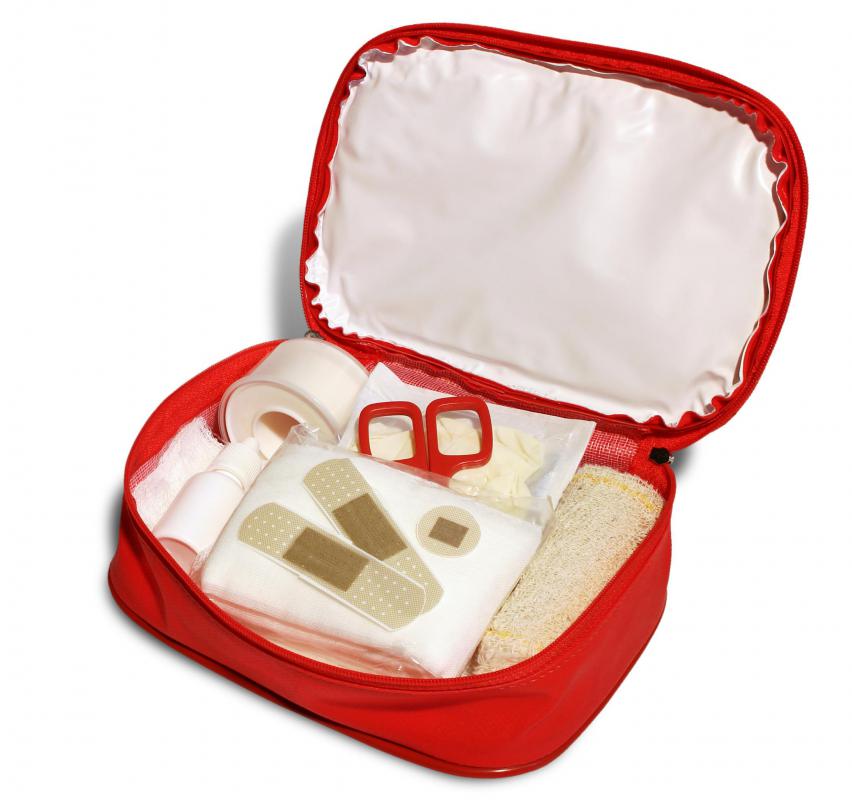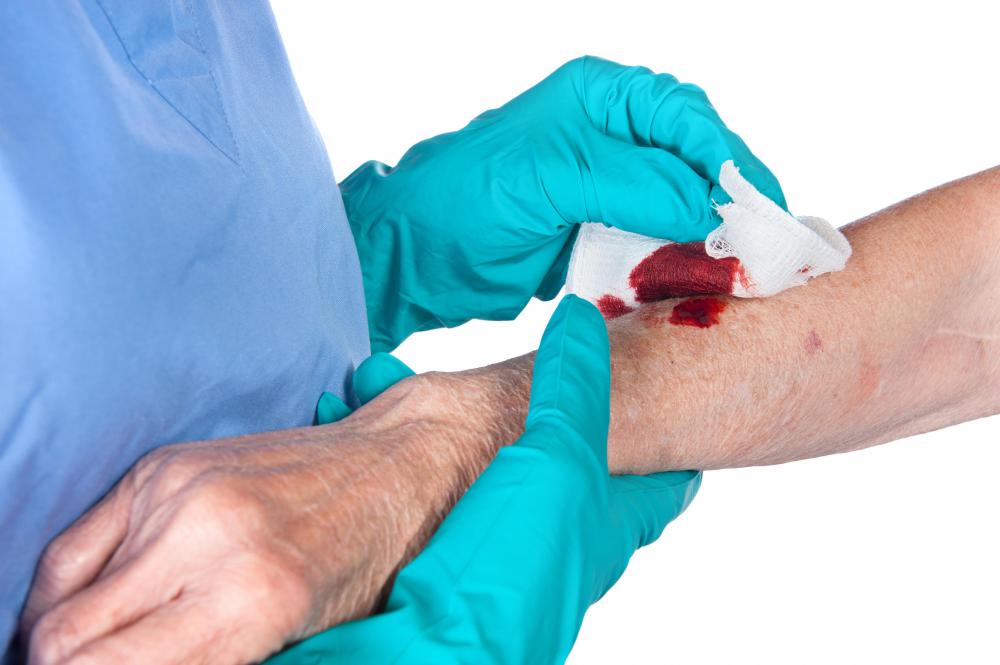At TheHealthBoard, we're committed to delivering accurate, trustworthy information. Our expert-authored content is rigorously fact-checked and sourced from credible authorities. Discover how we uphold the highest standards in providing you with reliable knowledge.
What are the Different Types of Gauze Sponges?
Gauze sponges are used in wound care for absorbing body fluids and providing protection from dirt and bacteria. There are several types of gauze sponges to choose from, including ABD pads, non-adhering dressing, gauze fluff rolls, self-adhering foam, and 2 x 2 inch (5.08 x 5.08 cm) and 4 x 4 inch (10.16 x 10.16 cm) gauze sponges. The type you choose is dependent upon the size and location of the wound.
ABD pads are used for treating and protecting large wounds. This type of sponge has three layers, including a non-woven facing, cotton filler and hydrophobic backing, to prevent body fluids from striking through. Due to the large array of sizes available, this dressing can be used for applying first aid to wounds located on any part of the body.

Non-adhering dressing is most often used for treating patients with first and second degree burns, grafts, venous and pressure ulcers, abrasions, nail extractions, lacerations and surgical incisions. This type of gauze is treated with a petrolatum emulsion to protect the skin from tearing when the dressing is changed or removed. The cotton inner layer absorbs drainage, which helps to keep the wound dry. Non-adhering dressing can be cut to the size of the wound without fraying at the edges, making it perfect for applying first aid to wounds of all sizes.

Gauze fluff rolls are used in basic wound care. They are made of woven gauze that is fluff dried, giving it a crinkle weave pattern. This design provides extra bulk to cushion and protect the wound. This dressing is distributed on a roll, allowing it to be wrapped securely around wounds located on limbs. These are most often used for securing bandages to wounds, providing extra absorbency and protection from bacteria.

Self-adhering foams are gauze sponges that are used to distribute a person's body weight and prevent breakdown of the skin around the wound. They are often places in casts and splints, as they self adhere to the equipment. Self-adhering foam can't be applied directly to the skin, as it causes irritation, but it can be used over dressing.
The 2 x 2 inch (5.08 x 5.08 cm) and 4 x 4 inch (10.16 x 10.16 cm) gauze sponges are the most commonly used bandages in basic wound care. They are found in most first aid kits, in these two sizes. Besides covering wounds, they can also be used for cleaning, sanitizing and absorption aides. Both sizes have an eight-ply thickness for extra absorbency.
AS FEATURED ON:
AS FEATURED ON:
















Discussion Comments
@tlcJPC - As somebody who has had two major surgeries, let me tell you that I have experience with gauze dressings at this point. One of the best ways to help detach gauze medical sponges that have attached to a wound is to moisten them under warm water in the shower.
One of my operations just so happens to have been adult male circumcision, which if you didn't know involves keeping gauze bandages on the penis for quite awhile after the surgery. Anyway, this is where I learned the gauze softening trick using the shower.
In fact, in that case things were so painful and sensitive that I would take an hour-long bath to let the gauze really soak and soften up before even attempting to pull it off and redress the wound. Even when I did that, I had to take pain reliever medication half an hour before redressing the wound so that I could stand it.
I can't even imagine how much it would have hurt and how much damage I might have done if I had attempted to pull the gauze off without softening it in hot water first -- I cringe just thinking about it. Gauze was very helpful for my recovery, though. It's one of those tools you have to respect when you use it, or you can definitely hurt yourself.
@aishia - I think tlcJPC is saying that gauze can become a bad thing if used improperly (say, by people who don't know how to clean and dress a wound properly) more than that gauze itself is at fault. It's true that even that "non-stick" gauze can stick to and leave fibers in a wound if left there for too long or pressed on too hard while the blood is coagulating.
Other no-nos about wound dressing include:
1. Not thoroughly cleaning the wound before bandaging it. Leaving grit or even germs from a knife blade in an injury is just asking for infection! Use mild soap and warm water.
2. sticking something else, like cotton balls, beneath the gauze to try to suck up the blood. Gauze is designed to absorb blood, people -- and cotton balls leave tons of fibers in a sticky injury!
3. Not changing the dressing often enough. Even if the wound was cared for correctly, complete with sterile gauze sponges and disinfectant ointment, if you leave that dressing on for days the blood that was sucked up into the gauze can grow bacteria in it.
4. Last but not least, if an injury smells bad at any time, that's sign of infection -- very bad, treat it immediately!
@nanny3 - I've never had an injury as big as the one your mother had, but I understand what you're referring to. My best experience with using gauze sponges and gauze pads has been after getting oral surgery to remove a tooth.
My gums had to have stitches put into them, and the spot where the tooth was removed bled for about hours after I left the dentist's office. The dentist had me put 2 by 2 inch gauze pads inside my mouth clenched between my upper teeth and the spot where that bottom molar used to be that was now covered in stitches.
I had to replace the gauze every hour or so as it got completely saturated with blood. Pulling the gauze out, I saw that it was completely soaked with and gelled over with coagulated blood, and I realized just how much my gums had been bleeding. I'll bet if I didn't have those 2 by 2 inch gauze pads to use after my oral surgery, I would have been spitting blood out for days!
The dentist told me that keeping the gauze in place also helped my gums to stop bleeding faster, because the gauze protected the stitches and injury and kept them undisturbed by things like swallowing until after the wound had closed up at least a little. I think the gauze made itself very useful that day.
@tlcJPC - There are nonstick varieties of gauze made for just this reason. If gauze sticking is still a problem, try putting some disinfectant ointment on the injury before covering it up.
Not only does this keep the area moist so that it doesn't stick to the gauze, but it helps keep the wound from getting infected and even creates a layer over it so that if any grit gets between the wound and the gauze, it won't get into the injury. It's a win/win/win situation, right?
Until a person has to actually care for a major wound that requires gauze, they might not appreciate or realize how important this one little tool is.
My poor mother had to have major surgery a few years ago, and unfortunately she had a lot of poor care from her physicians. She ended up with a gaping hole in her stomach area that just wouldn’t heal.
We cleaned, changed and packed this hole several times a day for months with a gauze dressing. I can’t imagine the mess she would have been in if she hadn’t been able to do this.
The gauze protected it and kept it clean, at the very least. That really was all that we could do.
There is nothing worse than having a really painful injury already and then putting a bandage on it that doesn’t help matters at all.
Come on. You know what I’m talking about. For example, you get a really bad scrape after a fall and put some sterile gauze on it and medical tape. It’s a little too big for a regular band aid, after all. Then it’s time to remove the dressing and the thing sticks. Ouch!
It is a very good idea to have at least some idea of the appropriate way to dress a wound before jumping right in; otherwise, you could actually cause more damage than was present before.
Post your comments